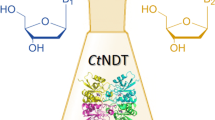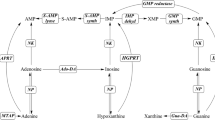Abstract
A library of strains producing recombinant nucleoside phosphorylases (NPs) and their mutant and hybrid forms from various mesophilic and extremophilic microorganisms was constructed based on Escherichia coli cells. Substrates were shown to stabilize the NP structure upon thermal exposure, with the inorganic phosphate ion playing a decisive role in the process. Bioinformatics analyses made it possible to assume that the N‑terminal structure of NPs is largely responsible for their thermal stability. A hybrid thymidine phosphorylase (TPP) was constructed via the replacement of the N-terminal fragment (amino acid residues 1–62) of E. coli TPP with the corresponding TPP fragment from the thermophilic bacterium Geobacillus stearothermophilus. Higher thermal stability was observed for the hybrid TPP. The primary structure of E. coli uridine phosphorylase (UDP) was found to have a sequence, 25-Pro-Gly-Asp-Pro-30 (amino acid residues are numbered as in E. coli UDP), that is highly conserved among UDPs of mesophilic microorganisms. The E. coli UDP (Asp27Gly) mutant was constructed and similarly showed a higher thermal stability than the original form. The architecture of the phosphate-binding site and features of its function were assumed to be crucial for the thermal stability of the enzyme.








Similar content being viewed by others
REFERENCES
Liekens, S., De Clercq, E., and Neyts, J., Biochem. Pharmacol., 2001, vol. 61, no. 3, pp. 253–270.
Carmeliet, P., Nature, 2005, vol. 438, no. 7070, pp. 932–936.
Furukawa, T., Tabata, S., Yamamoto, M., Kawahara, K., Shinsato, Y., Minami, K., Shimokawa, M., and Akiyama, S., Pharmacol. Res., 2018, vol. 132, pp. 15–20.
Bera, H. and Chigurupati, S., Eur. J. Med. Chem., 2016, vol. 124, pp. 992–1003.
Wei Li and Hong Yue, Trend.Card. Med., 2018, vol. 28, no. 3, pp. 157–171.
Mikhailopulo, I.A. and Miroshnikov, A.I., Acta Naturae, 2010, vol. 2, no. 2, pp. 38–61.
Kulikova, I.V., Drenichev, M.S., Solyev, P.N., Alexeev, C.S., and Mikhailov, S.N., Eur. J. Org. Chem., 2019, vol. 2019, no. 41, pp. 6999–7004.
Sambrook, J., Fritsch, E.F., and Maniatis, T., Molecular Cloning: A Laboratory Manual, New York: Cold Spring Harbor Laboratory Press, 1989.
Veiko, V.P., Siprashvili, Z.Z., Ratmanova, K.I., Gul’ko, L.B., Andryukhina, R.V., and Debabov, V.G., Biotekhnologoiya, 1994, no. 4, pp. 2–4.
Veiko, V.P., Siprashvili, Z.Z., Ratmanova, K.I., Gul’ko, L.B., Mironov, A.A., Andryukhina, R.V., and Debabov, V.G., Dokl. Akad. Nauk SSSR, 1994, vol. 339, no. 6, pp. 819–821.
Mordkovich, N.N., Manuvera, V.A., Veiko, V.P., and Debabov, V.G., Biotekhnologiya, 2012, no. 1, pp. 21–30.
Veiko, V.P., Chebotaev, D.A., Ovcharova, I.V., and Gul’ko, L.B., Russ. J. Bioorg. Chem., 1998, vol. 24, no. 5, pp. 335–340.
Antipov, A.N., Mordkovich, N.N., Khizhnyak, T.V., Okorokova, N.A., and Veiko, V.P., Appl. Biochem. Microbiol., 2020, vol. 56, no. 1, pp. 37–43.
Veiko, V.P., Osipov, A.S., Shekhter, I.I., Bulenkov, M.T., Ratmanova, K.I., Gul’ko, L.B., Chibiskova, N.A., Errais, L.L., Derevshchikova, E.B., and Debabov, V.G., Bioorg. Khim., 1995, vol. 21, no. 5, pp. 354–358.
Chebotaev, D.V., Gul’ko, L.B., and Veiko, V.P., Russ. J. Bioorg. Chem., 2001, vol. 27, no. 3, pp. 184–190.
Bradford, M.M., Anal. Biochem., 1976, vol. 2, pp. 248–254.
Laemmli, U.K., Nature, 1970, vol. 227, no. 5259, pp. 680–685.
Leer, J.C., Hammer-Jespersen, K., and Schwartz, M., Eur. J. Biochem., 1977, vol. 75, no. 1, pp. 217–224.
Cacciapuoti, G., Bertoldo, C., Brio, A., Zappia, V., and Porcelli, M., Extremophiles, 2003, vol. 7, pp. 159–168.
Trivedi, S., Gehlot, H.S., and Rao, S.R.,Gen. Mol. Res., 2006, vol. 5, no. 4, pp. 816–827.
Gianese, G., Bossa, F., and Pascarella, S., Proteins, 2002, vol. 47, pp. 236–249.
Vieille, C. and Zeikus, G.J., Microbiol. Mol. Biol. Rev., 2001, vol. 65, pp. 1–43.
Brock, T.D., Science, 1967, vol. 158, pp. 1012–1019.
Sawle, L. and Ghosh, K., Biophys. J., 2011, vol. 101, pp. 217–227.
Kumar, S. and Nussinov, R., Cell. Mol. Life Sci, 2011, vol. 58, pp. 1216–1233.
Karshikoff, A. and Ladenshtein, R., Prot. Eng., 1998, vol. 11, no. 10, pp. 867–872.
Kamel, S., Thiele, I., Neubauer, P., and Wagner, S.S., Biochim. Biophys., Acta—Prot. Proteom., 2020, vol. 1868, no. 2. https://doi.org/10.1016/j.bbapap.2019.140304
Visser, D.F., Hennessy, F., Rashamuse, J., Pletschke, B., and Brady, D., J. Mol. Cat. B: Enzym., 2011, vol. 68, pp. 279–285.
Oliva, I., Zuffi, G., Barile, D., Orsini, G., Tonon, G., De Gioias, L., and Ghisotti, D., J. Biochem., 2004, vol. 135, no. 4, pp. 495–499.
Luke, K.A., Higgins, C.L., and Wittung-Stafshede, P., FEBS J., 2007, vol. 274, pp. 4023–4033.
Imanaka, T., Proc. Jpn. Acad., Ser., 2011, no. 9, pp. 587–602.
Alemasov, N.A. and Fomin, E.S., Vavilov. Zh. Genet. Selekts., 2012, vol. 16, no. 4/1, pp. 774–783.
Grishin, D.V., Pokrovskaya, M.V., Podobed, O.V., Gladilina, Yu.A., Pokrovskii, V.S., Aleksandrova, S.S., and Sokolov, N.N., Biomed. Khim., 2017, vol. 63, no. 2, pp. 124–131.
http://gibk26.bio.kyutech.ac.jp/jouhou/Protherm/protherm.html.
Razvi, A. and Scholtz, J.M., Prot. Sci., 2006, vol. 15, no. 7, pp. 1569–1578.
Mordkovich, N.N., Safonova, T.N., Antipov, A.N., Manuvera, V.A., Polyakov, K.M., Okorokova, N.A., and Veiko, V.P., Appl. Biochem. Microbiol., 2018, vol. 54, no. 1, pp. 16–25.
Dumorne, K., Cordova, D.C., Astorga-Elo, M., and Renganathan, P., J. Microbiol. Biotechnol., 2017, vol. 27, no. 4, pp. 649–659.
Pucci, F., Dhanani, M., Dehouck, Y., and Rooman, M., PLoS One, 2014, vol. 9, no. 3. e91659.
Caradoc-Davies, T.T., Cutfield, S.M., Lamont, I.L., and Cutfield, J.F., J. Mol. Biol., 2004, vol. 337, no. 2, pp. 337–354.
Pugmire, M.J. and Ealick, S.E., Structure, 1998, vol. 6, no. 11, pp. 1467–1479.
Safonova, T.N., Mordkovich, N.N., Veiko, V.P., Okorokova, N.A., Manuvera, V.A., Dorovatovskii, P.V., Popov, V.O., and Polyakov, K.M., Acta Crystallogr. D: Struct. Biol., 2016, vol. 72, no. 2, pp. 203–210.
ACKNOWLEDGMENTS
This work was carried out on equipment of the Industrial Biotechnologies Collective Access Center of the Federal Research Center for Basics of Biotechnologies (Russian Academy of Sciences).
Funding
This work was supported by the Russian Foundation for Basic Research (project no. 18-04-00784A).
Author information
Authors and Affiliations
Corresponding author
Ethics declarations
The authors declare that they have no conflict of interest. This article does not contain any studies involving animals or human participants performed by any of the authors.
Additional information
Translated by T. Tkacheva
Rights and permissions
About this article
Cite this article
Mordkovich, N.N., Antipov, A.N., Okorokova, N.A. et al. The Nature of Thermal Stability of Prokaryotic Nucleoside Phosphorylases. Appl Biochem Microbiol 56, 662–670 (2020). https://doi.org/10.1134/S0003683820060125
Received:
Revised:
Accepted:
Published:
Issue Date:
DOI: https://doi.org/10.1134/S0003683820060125




